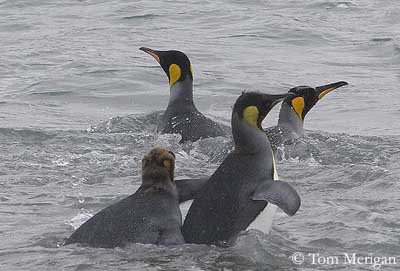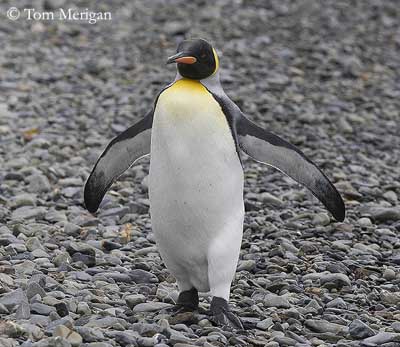
King Penguin
Aptenodytes patagonicus
Sphenisciforme Order – Spheniscidae
BIOMETRICS:
Length: 85-95 cm
Weight: 9 to 15 kg
LONGEVITY: Up to 26 years (41 in captivity)
DESCRIPTION:
King Penguin is smaller than Emperor Penguin. It is the second largest species of penguins.
Adult has dark grey to blackish upperparts, including tail and flippers.
Underparts are mainly white, but upper breast is orange-yellow bordered with black stripe on sides, becoming paler towards the lower breast. The under flippers is white, with conspicuous black tips. Leading edge is black.
PROTECTION / THREATS / STATUS:
King Penguin populations are stable or increasing, and they are not globally threatened at this moment.
King Penguin is preyed upon by Leopard seals and Killer Whales which kill adults and great shorebirds such as skuas, sheathbills and giant petrels which take eggs and attack the chicks.
Fr: Manchot royal
All : Königspinguin
Esp : Pingüino Rey
Ital : Pinguino reale
Nd : Koningspinguïn
Russe : королевский пингвин
Photographs by Tom Merigan
His website : Tom Merigan’s Photo Galleries
Text by Nicole Bouglouan
Sources:
HANDBOOK OF THE BIRDS OF THE WORLD vol 1 by Josep del Hoyo-Andrew Elliot-Jordi Sargatal - Lynx Edicions - ISBN: 8487334105
Antarctic Connection (Thomas Hutchings – Gloria Hutchings)
Animal Diversity Web (University of Michigan Museum of Zoology)
Les Manchots (François Durand)
New Zealand birds and birding (Narena Olliver)
Welcome to the wonderful world of penguins (Dr. Lloyd Davis)
Wikipedia (Wikipedia, The Free Encyclopedia)

Head is black, except the orange-yellow drop-shaped auricular patches, ending below the cheeks in fine orange-yellow stripe. The black plumage of the head becomes grey on the nape. Chin and throat are black.
Bill is straight and relatively long. It is black with an elongated oval orange patch at base of lower mandible, named “mandibular plate”. Eyes are dark brown. Strong legs and webbed feet are black.
Both sexes are similar.
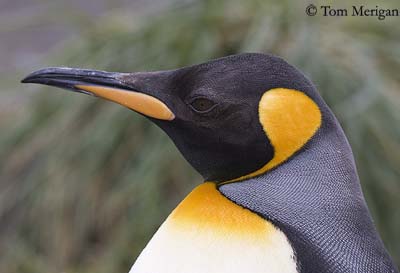
Juvenile has paler auricular patches and duller orange patch on lower mandible. It reaches its sexual maturity at 5 to 7 years of age.
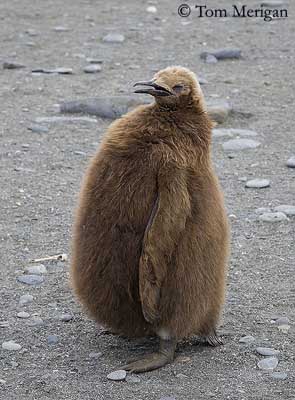
Chick is covered in thick brown down and at one year, it is almost tall than adults.
We find two subspecies, A.p. patagonicus, and A.p. halli. They differ in bill and flipper length.
VOICE: SOUNDS BY XENO-CANTO
In the King Penguins, male and female utter different sounds. The contact calls given by these penguins can be heard a kilometre away. During courtship displays, the male utters a trumpet-like song before copulation.
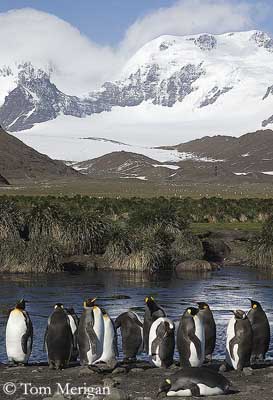
HABITAT:
King Penguin breeds on flat beaches, free of snow and ice, with scattered clumps of grass and close to the sea. It spends much time near the breeding area. King Penguin is pelagic outside the breeding season.
RANGE:
King Penguin lives and breeds on the sub-Antarctic islands, as well as Tierra del Fuego, the Falklands, and other temperate-cool islands in the same area.
BEHAVIOUR:
King Penguin feeds mainly on small fish and squid, but also krill and plankton. It feeds by pursuit-diving, and propels its body with feet and flippers. King Penguin is able to dive from 50 to 240 metres depth. It can remain underwater for 15 minutes or more if necessary.
These penguins often fish in groups and they travel hundreds of kilometres to find preys. They hunt daily during several hours.
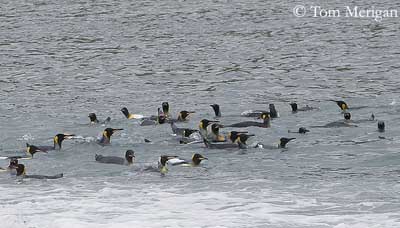
During the moult, King Penguin cannot dive, and lives on its body reserves. It can loose up to the half of its body mass. It can drink salt water when at sea, and it takes snow when on land or freshwater if it is available.
It dives for fish mainly during the daytime, but it can fish at night, performing shallow dives.
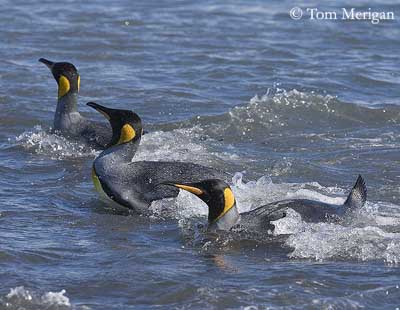
During breeding season, the male performs some displays such as stretching the head upwards, or throwing it back, or bowing. It exhibits excessively the head, displaying the orange auricular patches, in order to attract a female. Then, female chooses one male and answers its calls. They are monogamous during the breeding season.
King Penguin is sedentary, at least the adults which only perform some movements and dispersions. Juveniles mostly disperse in pelagic areas.
King Penguin breeds in large colonies of several thousands of penguins. Each pair has small territory, but this restricted area is strongly defended by both adults. Outside the breeding season, they are very gregarious.
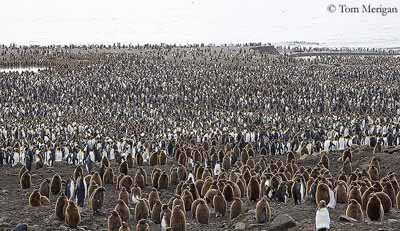
MOVEMENTS:
King Penguin does not fly. It walks relatively easily on land, and it also runs. In the snow, it moves by glides on the belly. It swims very well, at speed of up to 12 km per hour, and its dives last 15 minutes and more. It is able to dive from 150 to 300 metres depth, with observations at 500 metres. It uses its flippers to “fly” underwater.

REPRODUCTION:
King Penguin arrives at breeding colony in September-October, on flat coastal plains close to water. Their breeding cycle differs of that of other species, and pairs breeds twice every three years, because a full cycle lasts more than one year. That explains why eggs and large downy chicks are seen together within the same colony.
King Penguin does not build nest. Female lays only one egg, and incubation is shared by both parents. They keep the egg held on their feet for a period of about 52 to 56 days, with stints of 12 to 21 days. The egg of 300 g is protected from the ice by the feet and from the cold weather by the bare skin which adults have between the legs. During this period, the incubating adult moves very little, while the other parent goes to the sea for foraging.

When hatched, the chick is still held on parents’ feet during 30 to 40 days. During this period, it develops the plumage and little by little, it is able to regulate its own body temperature.
Parents take turns and chick may wait several days between two feedings. It is fed by regurgitated food into the mouth.
Later, the chick joins a crèche, allowing its parents to make prolonged foraging trips. The young is still dependent on them in mid-winter, and often waits for three months to be fed. It can loose half of its body mass at this period, and only healthy chicks are able to survive.
The chick usually fledges the next summer and reaches about 80% of the adult weight.
King Penguin usually returns to the same breeding area throughout its life. But these penguins often change mates each breeding season.
DIET:
King Penguin feeds mainly on small fish of about 15 cm, krill and squid. It catches its preys by pursuit-diving, and can remain underwater during 15 minutes and more, diving from 150 to 200-300 metres depth. King Penguin has often to travel hundreds of kilometres to find food.
